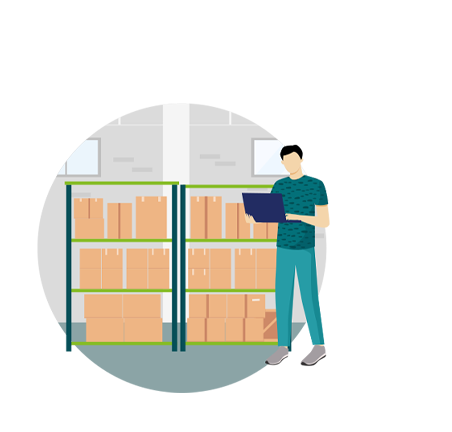
Foreword

Keith Lohkamp
Sr. Director Health Care Industry Strategy | Workday
Health care providers continue to face ongoing disruptions such as product shortages, rising costs, a shortage of talent and more. As supply chain leaders deal with these challenges, the need to transform both processes and technology to maintain efficiencies, reduce costs and develop a more resilient supply chain has never been more critical.
Workday helps health care organizations make this transformation through cloud Supply Chain Management solutions that expand sourcing capabilities, streamline source to pay processes, provide enhanced visibility to critical supplies, manage supply risk, and deliver actionable insights. To achieve this success, Workday incorporates a robust esoystem of service and software partners.
As an Industry Accelerator launch partner, Deloitte leverages their combined Health care and Workday experience to develop and deliver best practice solutions that speed time to value. This eBook explores some of these solutions and key considerations and opportunities for successful transformation utilizing Workday Supply Chain Management.


Contents
Chapter 01
Master Data Management
1. Deloitte Methodology for Rationalizing Data Across Multiple Systems
Chapter 02
Deployment Strategy
Chapter 03
Supplier Portal
Questions You're Asking
How do I move all of my data from multiple systems into a single Workday tenant?
Should we take
all of our hospitals
live at the same time via a “big bang” or should we take a phased approach?
How can we securely
introduce self-service
capabilities to
our suppliers?

Many health care organizations are focusing on growth as we move into a post-COVID world.
They are also turning to cloud-enablement to create a resilient supply chain. However, growth strategies, such as M&A, often create a complicated landscape of legacy systems and inconsistent vendor data that can impede the deployment of agile supply chain solutions such as Workday Supply Chain Management (SCM) for health care. While many health care leaders understand the value of moving to the cloud, they often want to know if a potential implementation partner has thought through some of the more complex challenges associated with supply chain transformation. The following is our response to some common questions that keep transformation leaders up at night.


Health care institutions that have grown though acquisitions can easily find themselves with tens of thousands of suppliers and hundreds of thousands of items spread across multiple systems.
Compounding the situation, the same vendors may be coded differently from one system to the next, making duplicates hard to spot and consistency difficult to achieve. It is impractical to bring such a massive, and largely duplicative, data set into Workday. This raises the question; how can an organization rationalize all of its data from multiple sources into one cohesive master data set?
With extensive experience in Workday-enabled transformation, Deloitte has developed a methodology for helping health care institutions to rationalize data across multiple systems and to prepare it to be loaded into Workday.
The Deloitte Methodology
01
Extract the suppliers, items and contracts from all of the different systems.
02
Rationalize the files (i.e., make them as small as possible) so you are only looking at relevant records that have been used in the last 18 months. Deloitte has developed a tool to accelerate this process. Using data extracted from the legacy systems, the tool categorizes the items and identifies those that require review. A data analyst can then review the items to see if they have been accessed recently and if they meet industry guidelines.
03
Continue the rationalization process, this time comparing the rationalized dataset from the legacy systems to the masters in the primary legacy database—usually that of the acquiring hospital—to eliminate duplicates and to identify the delta records, i.e., those that are not already included in the primary legacy database.
04
Few, if any, of the identified files from the legacy systems will have all of the data elements that Workday needs, so the last step is to enrich them. Deloitte can support the organization in performing this task through demonstrated methodologies and leading practices. Deloitte also has a proprietary automation tool, Hoover, for loading the enriched data into Workday.

Starting early is one key to successful master data management (MDM) during a Workday-enabled transformation. Another is understanding that the organization owns the MDM process, not the implementation partner.
When dealing with multiple legacy systems, MDM becomes a giant program management exercise where people and processes are central to making the project successful.
An experienced implementation partner like Deloitte can support your MDM efforts by helping you to establish a team with the proper mix of business and technical skills and part-time and full-time members. An effective MDM team is commonly staffed with data analysts; IT professionals who can help the implementation partner to understand the legacy data; supply chain managers who are familiar with the items, vendors and contracts within the system; and leaders who grasp the organization’s policies and procedures. Deloitte can assist by providing more details about what kinds of skills are required at each stage of the project as well as collaborating with your organization to ensure guidelines are followed.

It is also important for the team to meet at a steady cadence in alignment with project timelines. During team meetings, members should discuss progress as well as roadblocks and possible resolutions, and an ongoing issues log should be maintained.
Introduction to supply chain datasets
Master data management is an important aspect of any Workday implementation as the datasets needed to run a successful supply chain organization are all connected. These datasets commonly include item masters, supplier masters, supplier contract masters, and Periodic Average Replenishment (PAR) location data.

Item Master
The item master dataset houses all of the items in an organization’s inventory with the corresponding details. Each file contains key information about the item, such as a short description, the manufacturer’s name, supplier’s name, and unit of measure. Item masters are often similar across legacy systems, but there can be slight differences based on system configurations and how the data is being used.

Supplier Master
This dataset contains records of all of the suppliers/vendors with whom the organization does business. Most legacy systems have two different kinds of supplier datasets: remit and procurement.

Remit Vendor Dataset
Maintained by the accounts payable department, this dataset contains important information regarding remits made to the vendor. Commonly recorded information includes vendor/supplier address, contact details, default payment types, banking information, payment terms, and whether or not a purchase order was required.

Procurement Vendor Dataset
Maintained by the procurement department, this dataset contains important information regarding purchasing, including vendor/supplier addresses, contact details, purchase order submission type, banking information, and payment terms.

Supplier Contract Master
This dataset contains contract information, such as the contract header, a short description of the contract, vendor/supplier name, start and end dates, contracting company name, and contract type, such as direct to manufacturing, group purchasing organization, local, etc.

PAR Location Master
Par locations can be within stockrooms, in warehouses, or on hospital floors, and they may include supply closets, exchange carts, and moving carts that contain items or automated point-of-use systems. The concept behind par inventory management is to establish stock locations that can be replenished without tracking item on-hand quantities and material movement. With par inventory management, organizations can stock par locations with defined optimal item quantities, consume items as necessary, and then conduct periodic par counts to determine replenishment needs.

For many organizations, selecting a deployment strategy often comes down to support constraints.
In general, the number of support resources required for a big bang often exceeds the number of resources available. If outsourcing is out of the question, a phased deployment may be the most appropriate option.
For instance, a big bang approach might require dozens of support resources all at once, while a pilot might initially require one-third as many. Resources could also be deployed in three equal waves, which extends the deployment period but pulls the fewest number of people from their regular responsibilities at any given time. Overall, a phased deployment approach has the advantage of allowing the organization to train a core group during the pilot phase who can then serve as leaders during later phases. For this reason, some organizations choose to staff the pilot with a few more resources than they believe they will need.
Also, in some instances, local supply resources working in the hospitals can serve as super-users to assist with go-live readiness as well as support. Activities frequently include training support, FAQ resolution, and requisitioning assistance.
Support resources are personnel who are pulled from their day-to-day jobs to support their peers during the deployment. They receive super-user training and are asked to spend about 75 percent of their time on support tasks during the support period. This period is often most intense during the first 2–3 weeks, but duration and intensity can vary. Support tasks frequently span end-user training assistance, tech resources, integration support, team leads, and more.
To make an informed decision between a big bang and a phased deployment, it is critical to model the number and type of support resources that will be required as precisely as possible. The idea is to make sure end users receive the support they need without sacrificing operations. Some models are top down focusing on number of beds per facility. Others are bottom up focusing on transactions, number of procedural areas, etc. Drawing upon the know-how of our healthcare supply chain practitioners, Deloitte has developed a proprietary model that can help your organization to readily estimate the support resources it will require.

Manual workflows and paper-based processes can be a major impediment to procurement organizations that are charged with keeping spending under control.
Yet, costly paper invoices are often perceived as necessary evils. Vendors who are too small for EDI rely upon them, and the critical services and supplies provided by those vendors are too valuable to lose. Fortunately, there is a mutually beneficial way to shrink the paper piles, and for many Workday customers, it may be hiding in plain sight.
Workday Procurement’s supplier portal allows vendors to create invoices from purchase orders, view invoices and payment status, and maintain their own data, such as contact information, settlement banking data, alternate names, and classifications. By empowering suppliers with self-service capabilities and data-sharing, healthcare organizations can:
- Improve efficiency
- Eliminate manual errors
- Drive vendor compliance
- Control spending by getting more vendors on contract
- Collaborate more easily with suppliers.
Yet, some Workday customers hesitate to open up the supplier portal to their vendors due to risk-management concerns. Based on leading practices in supply chain management, the portal incorporates workflow controls and state-of-the-art safety and security protocols that put procurement and AP managers firmly in charge. With it, you can:
- Control information access so suppliers only see the information you want them to see
- Send “by-invitation-only” registration links directly to suppliers
- Automate vendor on-boarding processes using IRS-validated information
- Protect data by implementing proper security rules, such as creating specific user accounts with role-appropriate security levels and restricting those employees who have the ability to create purchase orders from manipulating vendor data.
EDI isn’t the only way to implement electronic invoicing and data-sharing. With deep Workday experience and a business-led, industry-specific approach to supply chain management, Deloitte can help your healthcare organization deploy Workday Procurement’s supplier portal for the joint advantage of your AP team members and your suppliers.


Rest easier in your decisions
As a leading Workday implementation partner, Deloitte can help you not only achieve a single source of supply chain data but also choose an appropriate deployment strategy and work with you each step of the way to empower your employees and your suppliers through a state-of-the-art supplier portal and other means. Common benefits of a Workday-enabled supply-chain modernization program include lowering operating costs, reducing time spent ordering supplies, and freeing clinicians to focus on delivering patient care.
Importantly, Workday’s supply chain solution is exclusively health care focused. With deep experience in both the health care sector and the supply chain function, we have both the business and technical know-how to answer your questions and to accelerate your implementation journey—ultimately enabling you to rest easier in your decisions.
Lower operating costs.
Reduce time spent ordering supplies.
Free clinicians to focus on
delivering patient care.
For more information, contact us today.

John Gunnigle
Senior Manager
Enterprise Performance, Life Sciences,
and Health Care
Deloitte Consulting LLP



